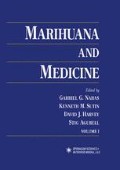Abstract
The topic of the pharmacokinetics of THC as illustrated by Harvey is very complex. But it is very important when you study a drug to look at some of the processes involved in its absorption, distribution, and elimination. We can vary drug dosages, and marihuana can be administered in a number of different ways: inhalation, orally and rectally. The drug dosage and the form in which it is administered greatly affects absorption. There are many other processes that determine not only what the free-drug concentration will be in the extracellular fluid, but also drug concentration at the site of drug action, which determines the pharmacodynamic effect. It is a complex situation that includes protein binding, storage in the tissues, metabolism, active and inactive metabolites, as well as mechanisms of excretion through biliary excretion with enterohepatic recirculation, fecal excretion, and renal excretion. The drug is also present in other biological tissues and fluids, including hair, saliva, and sweat (Fig. 1).
Access this chapter
Tax calculation will be finalised at checkout
Purchases are for personal use only
Preview
Unable to display preview. Download preview PDF.
References
Cone, E.J. (1997) New developments in biological measures of drug prevalence. NIDA Res. Monogr. 167, 108–129.
Cone, E.J., and Huestis, M.A. (1993) Relating blood concentrations of tetrahydrocannabinol and metabolites to pharmacologic effects and time of marijuana usage. Therapeutic Drug Monitoring. 15, 527–532.
Giardino, N.J. (1997) An indoor air quality-pharmacokinetic simulation of passive inhalation of marijuana smoke and the resultant buildup of 11-nor-delta-9-tetrahydrocannabinol-9-carboxylic acid in urine. J. Forensic Sci. 42, 323–325.
Giardino, N.J. (1996) Stability of 11-nor-delta 9-tetrahydrocannabinol in negative human urine in high-density polyethylene (Nalgene) [letter]. J. Anal. Toxicol. 20, 275–276.
Huestis, M.A., Mitchell, J.M., and Cone, E.J. (1995) Detection times of marijuana metabolites in urine by immunoassay and GC-MS. J. Anal. Toxicol. 19, 443–449.
Huestis, M.A., Mitchell, J.M., and Cone, E.J. (1996) Urinary excretion profiles of 11-nor-9 carboxy-delta 9-tetrahydrocannabinol in humans after single smoked doses of marijuana. J Anal Toxicol. 20, 441–452.
Jaeger, W., Benet, L.Z., and Bornheim, L.M. (1996) Inhibition of cyclosporine and tetrahydrocannabinol metabolism by cannabidiol in mouse and human microsomes. Xenobiotica.26, 275–284.
Jenkins., A.T., Darwin, W.D., Huestis, M.A., Cone, E.J., and Mitchell, J.M. (1995) Validity testing of the accuPINCH THC test. J. Anal. Toxicol. 19, 5–12.
Moore, C., Lewis, D., Becker, J., and Leikin, J. (1996) The determination of 11-nor-delta 9tetrahydrocannabinol-9-carboxylic acid (THCCOOH) in meconium. J. Anal. Toxicol. 20, 50–51.
Szirmai, M., Beck, O., Stephansson, N., and Halldin, M.M. (1996) A GC-MS study of three major acidic metabolites of delta 1-tetrahydrocannabinol. J. Anal. Toxicol. 20, 573–578.
Wilkins, D., Haughey, H., Cone, E., Huestis, M., Foltz, R., Rollins, D. (1995) Quantitative analysis of THC, 11-OH-THC, and THCCOOH in human hair by negative ion chemical ionization mass spectrometry. J. Anal. Toxicol. 19, 483–491.
Editor information
Editors and Affiliations
Rights and permissions
Copyright information
© 1999 Springer Science+Business Media New York
About this chapter
Cite this chapter
Huestis, M. (1999). Pharmacokinetics of THC in Inhaled and Oral Preparations. In: Nahas, G.G., Sutin, K.M., Harvey, D., Agurell, S., Pace, N., Cancro, R. (eds) Marihuana and Medicine. Humana Press, Totowa, NJ. https://doi.org/10.1007/978-1-59259-710-9_11
Download citation
DOI: https://doi.org/10.1007/978-1-59259-710-9_11
Publisher Name: Humana Press, Totowa, NJ
Print ISBN: 978-1-4757-5717-0
Online ISBN: 978-1-59259-710-9
eBook Packages: Springer Book Archive

